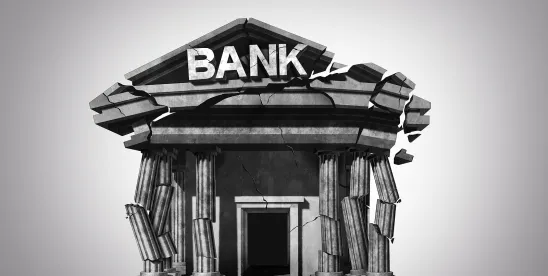In the second largest US bank failure since the 2008 global financial crisis, the California Department of Financial Protection and Innovation took over Silicon Valley Bank (“SVB”) on March 10 and appointed the Federal Deposit Insurance Corporation (“FDIC”) as SVB’s receiver. Just two days later, the New York State Department of Financial Services took over another bank, Signature Bank, and appointed the FDIC as receiver. And, yesterday, the share price of various European banks plunged following record one-day selloffs.
While this banking situation is evolving daily, the sudden insolvency of SVB and Signature Bank, and the ongoing issues plaguing other banks in the US and around the globe, has raised questions about insurance coverage that reach far beyond the extent of FDIC backstopping for US banks, including even questions about how the underwriting of affected coverages might change. We discuss these insurance issues below.
SVB and Signature Bank
SVB was the 16th largest bank in the US with more than $200 billion in assets. SVB focused on servicing the technology and venture capital community, becoming a mainstay for the start-up economy. SVB’s collapse followed a bank run that ensued last week. On March 9, 2023 alone, the bank’s clients sought to withdraw more than $40 billion of deposits, signaling its demise.
Signature Bank had around $110 billion in assets. Like SVB, Signature Bank had clientele in the tech sector, but also had significant ties to the real estate and legal industries. Signature Bank customers withdrew more than $10 billion in deposits following SVB’s failure, which raised regulators’ concerns about its financial health and led to its failure.
What Happens Next: Insurance Issues
The Insured Deposits in SVB and Signature Bank
Ordinarily, the FDIC needs to reimburse depositors up to $250,000. And on Friday, March 10, the FDIC announced it would do just that, with SVB depositors having access to those funds by the next Monday morning.
Yet, some 89% of SVB’s $175 billion in deposits exceeded the $250,000 per-depositor limit and were uninsured as of the end of 2022, leaving open the question of what would happen to these uninsured deposits.
The Federal Reserve, Treasury Department and FDIC answered that question on Sunday with an announcement that SVB’s failure presented a systemic risk to the financial system, allowing regulators to take the unusual step of guaranteeing all deposits, including those exceeding $250,000. “This step will ensure that the U.S. banking system continues to perform its vital roles of protecting deposits and providing access to credit to households and businesses in a manner that promotes strong and sustainable economic growth,” the agencies said in a joint statement. The Federal Reserve, Treasury Department and FDIC also announced a similar systemic risk exception for Signature Bank.
Based on these responses, the FDIC agreed to provide direct protection of all of the deposits at SVB and Signature Bank, including uninsured amounts above $250,000.
Directors and Officers Insurance
FDIC insurance applies only to deposits like checking and savings accounts. It does not apply to investors in the insolvent institution. It is likely, therefore (and, as discussed below, now a reality), that investor lawsuits will be filed against the directors, officers and management teams of the failed banks. These lawsuits will implicate the banks’ Directors and Officers (D&O) insurance policies.
On Monday, shareholders for SVB already filed a class action lawsuit in federal court in California against the bank’s parent company and its leaders. The shareholders, led by Chandra Vanipenta, allege the defendants, which include SVB’s CEO and CFO, concealed how rising interest rates would leave SVB “particularly susceptible” to a bank run. The plaintiffs seek unspecified damages for investors who backed the bank between June 16, 2021 and March 10, 2023.
The lawsuit already filed against two of SVB’s leaders illustrates the types of alleged conduct that affected shareholders will attribute to the cause of the banks’ failures. This conduct, if it meets the policy definition of an insured wrongful act, will implicate insurance coverage for the ensuing lawsuits. But shareholder class-action lawsuits will not be the only exposures to potentially implicate D&O insurance. When other banks or entities had relied on the failed banks and, in turn, face distress or failure, then their liquidating trustees, receivers or the like might also look to tap the failed banks’ insurance coverage to help benefit their estates.
In addition, stock-drop suits and other securities litigation might arise if there is a link between the price-drop and the failure by businesses to disclose connections with the collapsed banks in prior securities filings.
D&O insurance protects officers, board members, managers and other senior leadership against claims made by shareholders or third parties. Thus, entities like SVB and Signature Bank, or those affected by the banks’ collapses, that are accused of wrongdoing might look to their D&O policies if allegations are made against their leadership such as those described above.
Deal-Related Risk Management and Due Diligence
The selling of assets to keep the banks afloat, or total or partial acquisition of distressed banks, will also result in transactions that will trigger a host of transactions. For example, on Monday, HSBC, Europe’s largest bank, bought the UK-arm of SVB for a symbolic one pound. Assessment of insurance programs will be critical for the required due diligence and risk assessment associated with all of these transactions, including the availability of coverage for existing and future claims.
Underwriting Issues
The collapse of SVB and Signature Bank, as well as the ails afflicting other banks around the globe, has led consumers and investors to question the stability of other banks, including US mid-sized regional banks. These concerns might be shared by underwriters of D&O and Errors and Omission (E&O) insurance policies who might begin to assess in greater detail policyholders’ use of certain banks in the US and abroad. Underwriters could anticipate more claims to be made against certain policyholders for continuing to use or having used banks perceived to be unstable, and thus evaluate a policyholder’s risk profile accordingly.
Likewise, banking institutions can expect stricter and more intensive underwriting going forward, particularly for mid-size and smaller banks. To maximize their coverage options, banking institutions should involve key personnel, including legal department leaders during the policy application process, use brokers that have specialty experience in brokering policies for similarly-situated financial institutions, and engage coverage counsel.
Notice Issues
D&O policies impose notice obligations if a claim occurs against a policyholder like those discussed above. But they also allow policyholders to provide notice of circumstances that may give rise to a claim. Policyholders that face potential exposure arising from the recent banking failures may benefit from providing notice of circumstances proactively under a current D&O policy to ensure coverage in the current policy period for any resulting claims made after the policy period ends. Providing notice of circumstances, however, is often more onerous than in a traditional claim situation. Careful review and compliance with all policy obligations will ensure notices are accepted and no unexpected disputes arise in the event of a future claim.
Conclusion
As the SVB and Signature Bank failures show, many insurance issues are likely to arise following the collapse of a banking institution. These issues include, among others, coverage for claims by shareholders and third-parties against the institution’s leaders, due diligence and risk management for restructuring deals and underwriting concerns when procuring new coverage. Engaging experienced risk professionals, including coverage counsel, during policy placement and claims handling can help ensure policyholders maximize their coverage options if a banking failure occurs.







 />i
/>i
